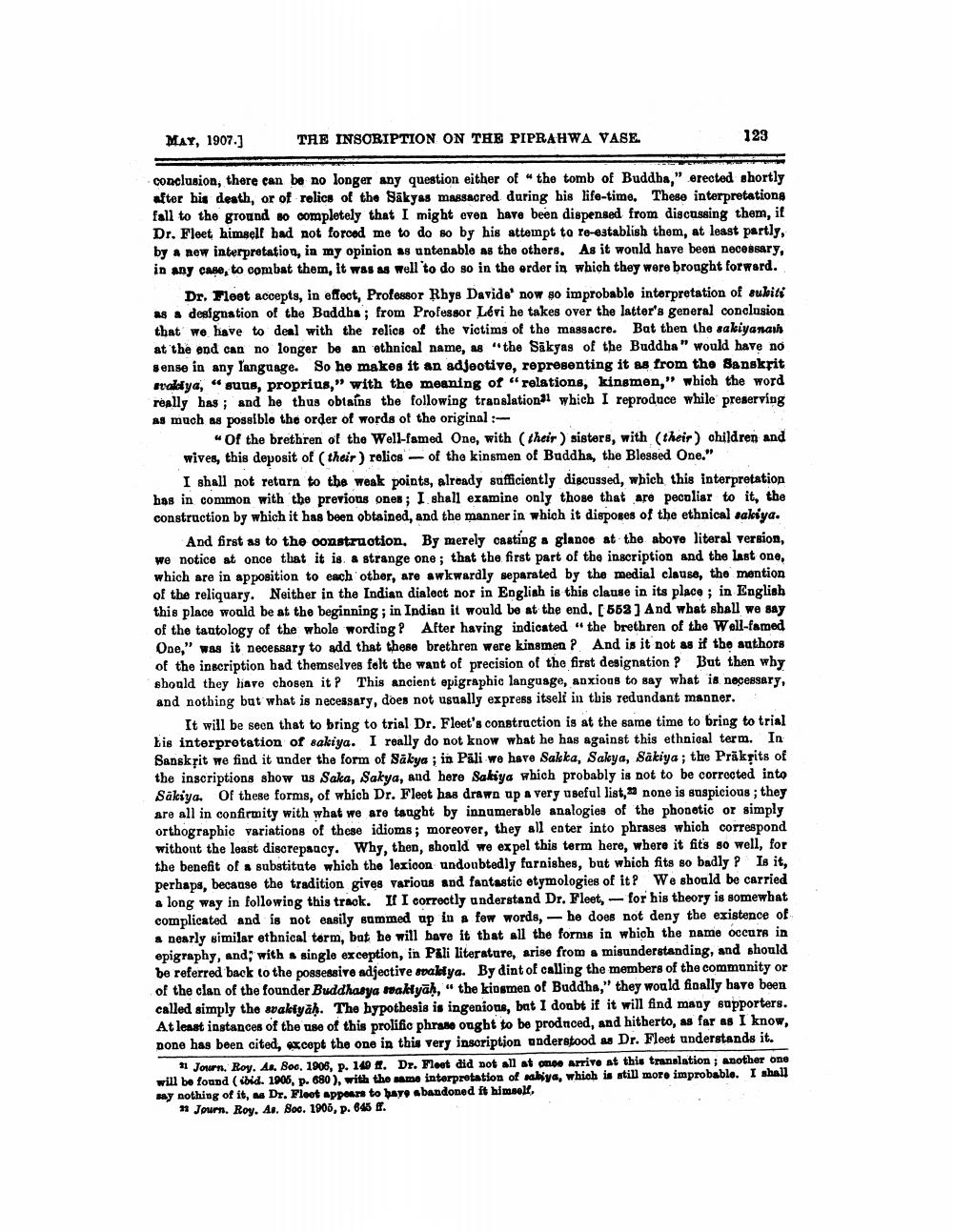________________
MAY, 1907.]
THE INSCRIPTION ON THE PIPRAHWA VASE.
123
conclusion, there can be no longer any question either of the tomb of Buddha," erected shortly after his death, or of relics of the Sākyas massacred during his life-time. These interpretations fall to the ground so completely that I might even have been dispensed from discussing them, if Dr. Fleet himself bad not forood me to do so by his attempt to re-establish them, at least partly, by a new interpretation, in my opinion as untenable as the others. As it wonld have been necessary, in any case, to combat them, it was as well to do so in the order in which they were brought forward.
Dr. Fleet accepts, in effect, Professor Rhys Davide' now so improbable interpretation of subits as a designation of the Baddha; from Professor Léri he takes over the latter's general conclusion that we have to deal with the relics of the victims of the massacro. Bat then the sakiyanah at the end can no longer be an ethnical name, as "the Sākyas of the Buddha" would have no sense in any language. So he makes it an adjeotive, representing it as from the Sanskrit madya, “suus, proprius," with the meaning of "relations, kinsmen," which the word really has ; and he thus obtains the following translational which I reproduce while preserving as much as possiblo the order of words of the original :
"Of the brethren of the Well-famed One, with (their) sisters, with (their) children and wives, this deposit of (their) relics of the kinsmen of Buddha, the Blessed One."
I shall not return to the weak points, already sufficiently discussed, which this interpretation has in common with the previous ones; I shall examine only those that are peculiar to it, the construction by which it has been obtained, and the manner in which it disposes of the ethnical sakiya.
And first as to the oonstruotion. By merely casting a glance at the above literal version, we notice at once that it is a strange one; that the first part of the inscription and the last one, which are in apposition to each other, are awkwardly separated by the medial clause, the mention of the reliquary. Neither in the Indian dialect nor in English is this clause in its place; in English this place would be at the beginning; in Indian it would be at the end. [553] And what shall we say of the tantology of the whole wording? After having indicated “the brethren of the Well-famed One," was it necessary to add that these brethren were kinsmen ? And is it not as if the authors of the inscription had themselves felt the want of precision of the first designation ? But then why should they have chosen it? This ancient epigraphic language, anxious to say what is necessary, and nothing but what is necessary, does not usually express itself in this redundant manner.
It will be seen that to bring to trial Dr. Fleet's construction is at the same time to bring to trial bis interpretation of sakiya. I really do not know what he has against this ethnical term. In Sanskrit we find it under the form of Säkya ; in Pāli we have Sakka, Sakya, Säkiya ; the Präkpits of the inscriptions show us Saka, Sakya, and here Sakiya which probably is not to be corrected into Sakiya. Of these forms, of which Dr. Fleet has drawn up a very useful list, * none is suspicious; they are all in confirmity with what we are taught by innumerable analogies of the phonetic or simply orthographic variations of these idioms; moreover, they all enter into phrases which correspond withont the least discrepancy. Why, then, should we expel this term here, where it fits so well, for the benefit of a substitute which the lexioon undoubtedly farnishes, but which fits so badly? Is it, perhaps, because the tradition gives various and fantastic etymologies of it? We should be carried a long way in following this track. If I correctly understand Dr. Fleet, - for his theory is somewhat complicated and is not easily summed up in a few words, - he does not deny the existence of s nearly similar ethnical term, but he will have it that all the forms in which the name occurs in epigraphy, and; with a single exception, in Pali literature, arise from a misunderstanding, and should be referred back to the possessive adjective walya. By dint of calling the members of the community or of the clan of the founder Buddhasya wakiyah," the kingmen of Buddha," they would finally have been called simply the avallyah. The hypothesis is ingenious, but I doubt if it will find many supporters. At least instances of the use of this prolific phrase ought to be prodnced, and hitherto, as far as I know, none has been cited, except the one in this very inscription understood as Dr. Fleet understands it.
#1 Journ, Roy. As Boo, 1906, P. 1991. Dr. Flest did not all at ono arrive at this translation; another one will be found (ibid. 1906, p. 680), with the same interpretation of makiya, which is still more improbable. I shall may nothing of it, as Dr. Floot appears to have abandoned it himself,
* Journ. Roy. As. Soc. 1906, p. 646 ff.




